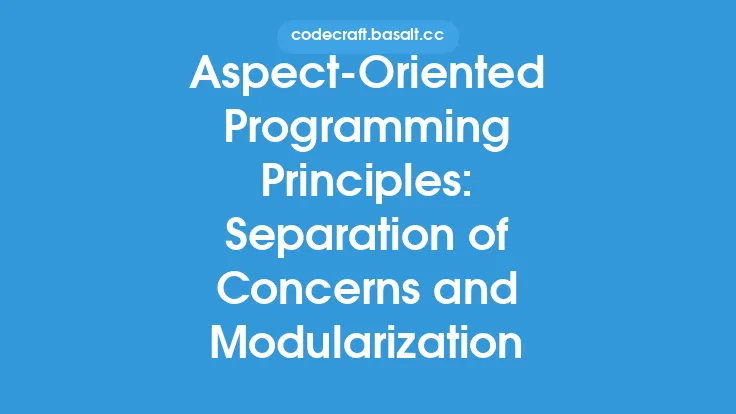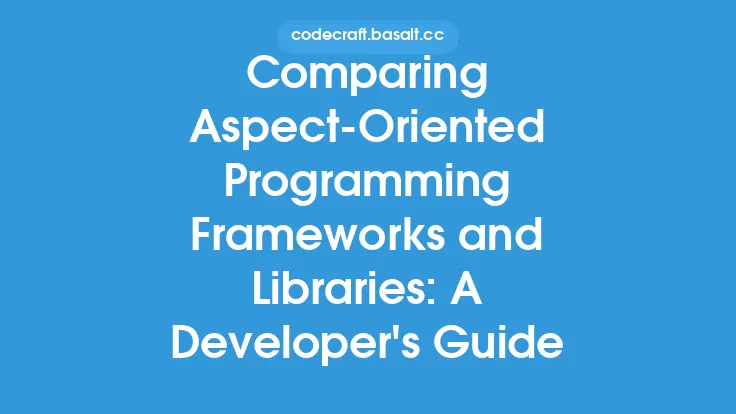Aspect-Oriented Programming (AOP) has emerged as a powerful paradigm for improving the maintainability and scalability of software systems. By modularizing cross-cutting concerns, AOP enables developers to reduce technical debt, which refers to the cost of implementing quick fixes or workarounds that need to be revisited later. Technical debt can accumulate over time, making it challenging to maintain and evolve software systems. In this article, we will explore how AOP can help reduce technical debt and improve software maintenance.
Introduction to Technical Debt
Technical debt is a concept introduced by Ward Cunningham, which refers to the cost of implementing quick fixes or workarounds that need to be revisited later. It can arise from various sources, including poor design, inadequate testing, and incomplete implementation. Technical debt can have significant consequences, such as increased maintenance costs, reduced system reliability, and decreased developer productivity. AOP can help reduce technical debt by providing a modular and flexible way to implement cross-cutting concerns, which are concerns that cut across multiple modules or components of a system.
Modularizing Cross-Cutting Concerns
Cross-cutting concerns, such as logging, security, and caching, are concerns that affect multiple modules or components of a system. Traditional programming approaches often implement these concerns using scattered code, which can lead to code duplication, tangling, and scattering. AOP addresses this issue by providing a way to modularize cross-cutting concerns using aspects, which are modules that encapsulate a specific concern. Aspects can be woven into the main codebase using various techniques, such as compile-time weaving, load-time weaving, or runtime weaving. By modularizing cross-cutting concerns, AOP enables developers to reduce code duplication, improve code readability, and increase system maintainability.
Aspect-Oriented Programming and Separation of Concerns
AOP is based on the principle of separation of concerns (SoC), which states that a system should be divided into independent components, each addressing a specific concern. SoC is essential for reducing technical debt, as it enables developers to modify or replace individual components without affecting the entire system. AOP takes SoC to the next level by providing a way to modularize cross-cutting concerns, which are concerns that cannot be easily separated using traditional programming approaches. By separating concerns, AOP enables developers to reduce the complexity of their codebase, improve system maintainability, and increase developer productivity.
Reducing Technical Debt with Aspect-Oriented Programming
AOP can help reduce technical debt in several ways. Firstly, it enables developers to implement cross-cutting concerns in a modular and flexible way, which reduces code duplication and improves code readability. Secondly, it provides a way to separate concerns, which reduces the complexity of the codebase and improves system maintainability. Thirdly, it enables developers to implement aspects that can be easily modified or replaced without affecting the entire system, which reduces the cost of maintenance and evolution. Finally, it provides a way to implement automated testing and validation, which reduces the risk of errors and improves system reliability.
Best Practices for Reducing Technical Debt with AOP
To reduce technical debt using AOP, developers should follow several best practices. Firstly, they should identify cross-cutting concerns that can be modularized using aspects. Secondly, they should design aspects that are independent, modular, and reusable. Thirdly, they should use weaving techniques that are flexible and scalable. Fourthly, they should implement automated testing and validation to ensure that aspects are correct and reliable. Finally, they should continuously monitor and refactor their codebase to ensure that it remains maintainable and scalable.
Tools and Frameworks for Aspect-Oriented Programming
Several tools and frameworks are available to support AOP, including AspectJ, Spring AOP, and JBoss AOP. These tools and frameworks provide a range of features, such as aspect definition, weaving, and runtime support. Developers can choose the tool or framework that best fits their needs, depending on the complexity of their system, the size of their team, and the requirements of their project. When selecting a tool or framework, developers should consider factors such as ease of use, performance, and scalability.
Case Studies and Examples
Several case studies and examples demonstrate the effectiveness of AOP in reducing technical debt. For instance, a study by the Software Engineering Institute found that AOP can reduce maintenance costs by up to 30% and improve system reliability by up to 25%. Another study by the University of California found that AOP can improve developer productivity by up to 40% and reduce the complexity of the codebase by up to 30%. These case studies and examples demonstrate the potential of AOP to reduce technical debt and improve software maintenance.
Conclusion
In conclusion, AOP is a powerful paradigm for improving the maintainability and scalability of software systems. By modularizing cross-cutting concerns, AOP enables developers to reduce technical debt, which can accumulate over time and make it challenging to maintain and evolve software systems. By following best practices, using appropriate tools and frameworks, and considering case studies and examples, developers can effectively reduce technical debt using AOP. As software systems continue to grow in complexity and size, AOP is likely to play an increasingly important role in reducing technical debt and improving software maintenance.





